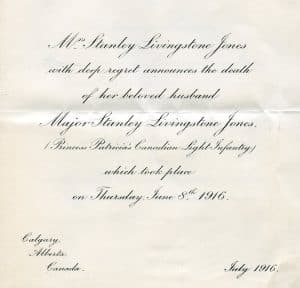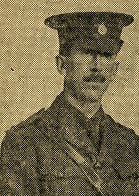 “Your husband is dead. He died in this hospital at 4 p.m.”
“Your husband is dead. He died in this hospital at 4 p.m.”
This was the first line of a telegram Alice B. Jones – Stanley Jones’s wife – received from fellow prisoner of war, Eugene P. Buonaparte, informing her of her husband’s death. The telegram went on to explain that the doctors did all they could, but were unable to control his internal bleeding and loss of blood.
Continuing LASA’s series commemorating Alberta lawyers who fought for Canada in World War I, Stanley Livingstone Jones was born in Wolfville, Nova Scotia on June 16, 1878. He moved to Calgary in 1901 where he practiced law at the firm Lent & Jones Co. In 1904, he married Alice B. Todd from Walkerton, Ontario. During World War I, she was also active with the Red Cross. In fact, she received the above telegram while serving as a nursing sister in France.
Stanley Jones was President of the Canadian South African Veterans Association, a member of the Canadian Club and the Independent Order of Odd Fellows. In his spare time, he was active in mountaineering and rifle shooting. In contemporary newspaper clippings that reported on his death, speculation was abound that had he returned from Europe he would have engaged in politics having been an active member of the Liberal Party both federally and provincially.
Military life was in Stanley Jones’s DNA. Not only did he serve Canada during the Great War. He served as a Private from 1899 to 1901 in the South African War (commonly known as the Boer War), where he was presented with a medal and four clasps. Jones also wanted to serve in the Balkans War in the years just prior to World War I. Though he journeyed to the region, he was restricted to writing correspondence, as an observer, detailing his experiences. Unfortunately, it seems that none of his writings survived.
It is no surprise that when war broke out in Europe in August 1914 Jones jumped at the chance for a new adventure to fight for King and Empire. In fact, he was the first Calgarian to do so. After volunteering with Calgary’s Princess Patricia Canadian Light Infantry, he was commissioned as a Lieutenant and received two battlefield promotions to Major.
During the war he was wounded three times, including being shot in the hand from which he suffered loss of function except for his thumb and little finger. His second injury was to his foot and was much less severe.
His third injury proved to be fatal. The Princess Patricias were involved in a battle near Santuary Wood, Belguim, where on June 2, 1916, Jones was wounded in the left lung while under heavy artillery bombardment. He was captured the next day and taken to a prisoner of war camp in Germany. In the confusion of battle, initial reports were sketchy. It was reported that he was wounded, then missing, then severely wounded, but finally reported captured by the German army.
It was during his capture that doctors were unable to repair the damage caused by the wound to his lung, and he eventually succumbed to his injuries on June 8, 1916. The telegram written to his wife on June 9 was not received until over a moth later on July 11, 1916.
When courthouse staff in Calgary learned of his death, they remembered an appeal Jones made on behalf of Jim Ham. One staff member was heard saying, “the best head had ever heard.” Jim Ham was charged with murder after having shot an R.C.M.P. Constable. There was little doubt that Ham had fired the first shot. However, with a strong appeal made by Jones, the jury eventually returned a verdict of not guilty.
As a tribute, a school in Calgary was named after Stanley Livingstone Jones. In 2013, this school celebrated its centennial. The building was declared a heritage site as one of the old sandstone edifices remaining in Calgary. It continues to be used for its initial purpose.
At the Law Society of Alberta’s Convocation in Banff on July 3 – 5, 1913, Stanley Livingston Jones, K.C. and Charles Arthur Wilson of Edmonton were recognized for their ultimate sacrifice for Canada and Great Britain. Two students-at-law were also recognized for being killed in action: Desmond St. Clare George and Thomas Harold Fennel.



